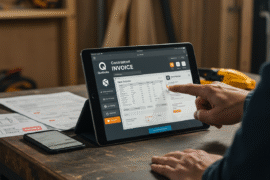This article may contain references to products or services from one or more of our advertisers or partners. We may receive compensation when you click on links to those products or services. Nonetheless, our opinions are our own.
The information presented in this article is accurate to the best of our knowledge at the time of publication. However, information is subject to change, and no guarantees are made about the continued accuracy or completeness of this content after its publication date.
Neobanks are online banks that operate without physical branches. They offer modern banking services primarily through apps and websites, setting them apart from traditional banks that rely on face-to-face service at physical locations. Neobanks typically offer fewer fees, faster account setup, and a more user-friendly experience. While traditional banks provide a broader range of services, such as loans and investment advice, neobanks prioritize convenience and technology to deliver a simpler, more accessible banking experience.
In recent years, you may have heard about neobanks and wondered what they are. These banks operate entirely online, offering a simple and accessible way to manage your money from anywhere. Unlike traditional banks, which involve physical branches and numerous fees, neobanks streamline your banking experience. They also offer digital tools that align with your needs. So what makes them different from traditional banks? This article explores the core features of neobanks, their benefits, and how they may fit into your financial life—helping you decide whether this modern form of banking is right for you.
What Makes Neobanks Different from Traditional Banks?
Neobanks are a new type of bank, offering a distinct experience compared to traditional banks. They operate entirely online, without any physical locations. Traditional banks, on the other hand, have in-person branches that allow for face-to-face service. Neobanks are known for their fast account setup, low fees, and user-friendly digital platforms. They leverage technology to deliver an easier experience, whereas traditional banks tend to adapt more slowly and rely on conventional methods. For those who prefer digital convenience and cost-effective service, neobanks can be a strong alternative.
By eliminating physical locations, neobanks provide core banking services—such as savings accounts, checking accounts, and money transfers—at lower costs. Their fully digital nature allows for faster innovation and improved tools. Some of their standout features include:
- Low Fees: Without the overhead of physical branches, neobanks can offer accounts with no monthly maintenance fees or transaction charges.
- User-Friendly Interfaces: Their apps are designed for simplicity, making it easy to manage your finances anytime, anywhere.
- Innovative Features: Neobanks often include budgeting tools, instant alerts, and financial insights that help you better understand your spending habits.
In comparison, traditional banks tend to have more complicated fee structures, may require a minimum balance to avoid charges, and often lack the same level of digital integration.
Bank vs. Neobank Comparison
| Feature | Bank (Traditional) | Neobank (Digital Bank) |
|---|---|---|
| Definition | A financial institution that accepts deposits from the public and creates credit. | A type of direct bank that operates exclusively online without traditional physical branch networks. |
| Physical Presence | Typically includes physical branches, ATMs, and in-person services. | Primarily or exclusively online, accessible via mobile apps and websites. |
| Regulation | Subject to established and often extensive regulations by central banks and government agencies. | Subject to varying levels of regulation, depending on their licensing and structure; often partnered with or subsidiaries of regulated banks. |
| Services Offered | Broad range of services, including savings accounts, checking accounts, loans, mortgages, investment services, and financial advisory. | Focus on core banking services like checking and savings accounts, money transfers, and sometimes basic lending; often leverage technology for streamlined experiences. |
| Customer Experience | Varies; can include in-person interactions, phone support, and online banking. | Emphasis on user-friendly mobile apps, fast online account opening, and digital customer support. |
| Operational Costs | Higher due to maintaining physical branches and infrastructure. | Lower overhead costs due to the absence of physical branches. |
| Innovation/Technology | Adapting to digital trends, but sometimes slower to adopt new technologies. | Built on technology, leveraging fintech innovations for efficiency and user experience. |
| Target Audience | Wide range of customers, including individuals, businesses, and institutions. | Often targets tech-savvy individuals, millennials, and those seeking convenient, digital banking solutions. |
| Licensing | Holds traditional banking licenses. | may or may not hold full banking licenses. Sometimes they partner with banks that do. |
Voted "Best Overall Budgeting App" by Forbes and WSJ
Monarch Money helps you budget, track spending, set goals, and plan your financial future—all in one app.
Get 50% OFF your first year with code MONARCHVIP
Everyday Benefits of Using a Neobank
Neobanks have transformed how people manage everyday transactions. Their blend of convenience and affordability offers significant advantages over traditional banks. Thanks to fully digital platforms, you can access your account 24/7 from any location—without needing to visit a physical branch. Here are some of the main benefits:
- Lower Fees: Many neobanks eliminate monthly fees and reduce costs associated with common transactions like ATM withdrawals.
- User-Friendly Apps: Simple, intuitive designs help you monitor spending and create budgets right from your phone.
- Fast Sign-Up: Opening an account typically takes only a few minutes, removing the paperwork and delays of traditional banking.
Built-in tools like budgeting features and real-time transaction alerts help you stay in control of your finances. Some neobanks even offer automatic savings programs or cashback rewards, maximizing the value of every dollar. These features put control in your hands and simplify the way you manage money.
How Neobanks Protect Your Money
Security is a natural concern when managing money online. Fortunately, neobanks implement strong protective measures to ensure your personal and financial information remains safe. Common strategies include:
- Encryption: Advanced encryption protocols keep your data secure both during transmission and while stored.
- Two-Factor Authentication (2FA): Adds a layer of security by requiring verification beyond just a password.
- Real-Time Monitoring: Many neobanks use AI to detect and respond to suspicious activity as it happens.
- Regulatory Compliance: Most neobanks follow strict financial regulations, including insurance protection from institutions like the FDIC or CDIC.
Are Neobanks FDIC Insured?
Yes, many neobanks are insured through partner banks that are members of the FDIC. This means deposits are typically protected up to $250,000, just like at traditional banks. Always check the fine print to verify that your chosen neobank is backed by FDIC (or equivalent) insurance coverage.
Finding the Right Neobank for Your Financial Goals
Choosing the right neobank involves assessing your financial needs and preferences. While many offer no monthly fees and well-designed apps, their services and fee structures can differ. Consider the following when comparing options:
- Very low or no ATM fees
- High-yield savings accounts
- Mobile check deposit availability
Selecting a neobank that aligns with your lifestyle ensures you won’t need to change your habits to suit the bank’s policies.
Also, make sure to evaluate each provider’s security standards, such as encryption and 2FA, and review their customer service channels. If you value timely support, look for live chat, email, or phone access. Here’s a quick feature comparison:
| Neobank | Monthly Fees | ATMs Nationwide | Interest Rate (Savings) |
|---|---|---|---|
| Neobank A | No Fee | 32,000+ | 2.00% |
| Neobank B | No Fee | 24,000+ | 1.50% |
| Neobank C | No Fee | 30,000+ | 1.75% |
Reviewing these options helps you find the best neobank to meet your financial needs.
Examples of Popular Neobanks
Several neobanks have gained popularity in recent years for offering accessible, tech-driven banking services. Examples include:
Chime
Chime focuses on simplicity and user needs. It offers features like early direct deposit, no monthly fees, and round-up savings. Its mobile app is intuitive and designed for users who want a smooth, digital-first banking experience.
Varo
Varo provides fee-free banking with widespread ATM access and competitive savings interest rates. It’s a strong choice for those seeking modern tools and consistent growth through high-yield savings.
Current
Current stands out with features like gas hold refunds and reward points for purchases. It targets users looking for personalized money management, early direct deposit, and financial tools that support day-to-day control.
Get the Most Out of Your Money with Neobank Features
Neobanks provide a variety of tools designed to help you manage your money with greater ease. These features include:
- Real-Time Notifications: Get alerts for every transaction to help monitor your spending.
- Integrated Budgeting Tools: Automatically categorize expenses and find ways to save.
- Goal-Oriented Savings: Set and track savings goals for travel, emergencies, or big purchases.
- Clear Fee Structures: Avoid hidden charges with straightforward account terms.
Most neobanks provide mobile apps, letting you manage your money from anywhere. Here’s a snapshot of what you can expect:
| Feature | Benefit |
|---|---|
| Mobile App Accessibility | Control your finances anytime, anywhere |
| Automated Savings | Grow your savings effortlessly |
| Peer-to-Peer Payments | Send and receive money instantly |
| Investment Options | Explore simple tools to grow your money |
Using these features helps you stay organized, make smarter financial decisions, and feel more in control of your future.
Frequently Asked Questions
What exactly is a neobank?
A neobank is a bank that operates exclusively online without physical branches. These banks use technology to deliver easy-to-use financial services through mobile and web platforms.
How do neobanks differ from traditional banks?
Neobanks are fully digital, which helps reduce costs. As a result, they often offer lower fees and better digital experiences compared to traditional banks, which maintain physical locations and in-person services.
What services do neobanks typically offer?
Neobanks typically provide checking and savings accounts, budgeting tools, and payment processing. Some also offer loans or investment options, depending on the provider.
Who benefits most from using a neobank?
Tech-savvy users who prefer mobile banking and want fewer fees benefit most from neobanks. Younger users and those seeking simplicity in money management often find them especially appealing.

Reviewed and edited by Albert Fang.
See a typo or want to suggest an edit/revision to the content? Use the contact us form to provide feedback.
At FangWallet, we value editorial integrity and open collaboration in curating quality content for readers to enjoy. Much appreciated for the assist.
Did you like our article and find it insightful? We encourage sharing the article link with family and friends to benefit as well - better yet, sharing on social media. Thank you for the support! 🍉
Article Title: Neobanks vs. Traditional Banks: Where to Find 2.00% Interest on Savings
https://fangwallet.com/2025/05/24/neobanks-vs-traditional-banks/The FangWallet Promise
FangWallet is an editorially independent resource - founded on breaking down challenging financial concepts for anyone to understand since 2014. While we adhere to editorial integrity, note that this post may contain references to products from our partners.
The FangWallet promise is always to have your best interest in mind and be transparent and honest about the financial picture.
Become an Insider

Subscribe to get a free daily budget planner printable to help get your money on track!
Make passive money the right way. No spam.
Editorial Disclaimer: The editorial content on this page is not provided by any of the companies mentioned. The opinions expressed here are the author's alone.
The content of this website is for informational purposes only and does not represent investment advice, or an offer or solicitation to buy or sell any security, investment, or product. Investors are encouraged to do their own due diligence, and, if necessary, consult professional advising before making any investment decisions. Investing involves a high degree of risk, and financial losses may occur including the potential loss of principal.
Source Citation References:
+ Inspo
There are no additional citations or references to note for this article at this time.












































